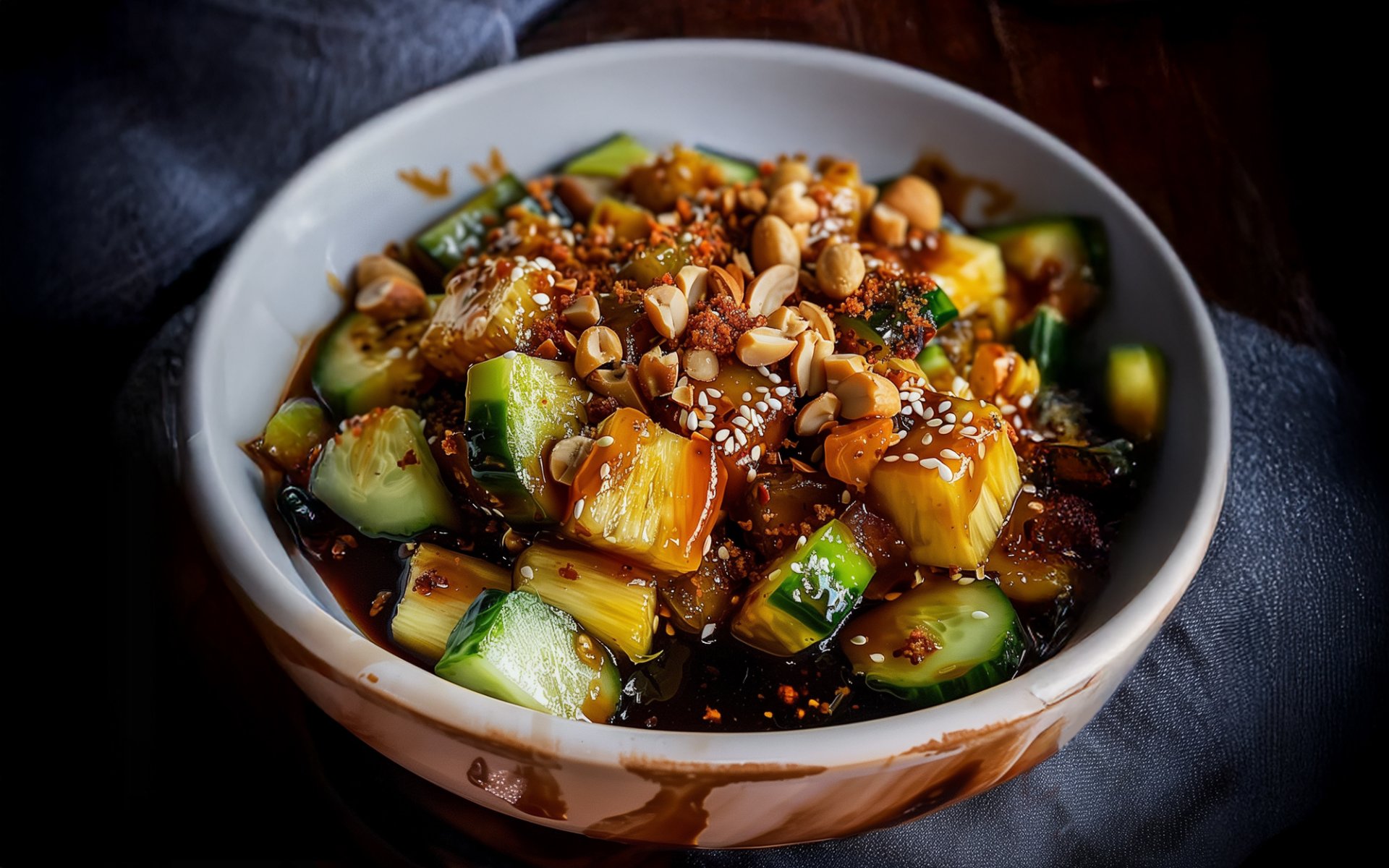Rojak

Rojak (Rojak) is a type of salad or "yum" dish originating from the Javanese people, consumed in Indonesia and neighboring countries such as Malaysia, Singapore, and Southern Thailand. Rojak consists of various fruits and vegetables, sliced into bite-sized pieces, tossed with a spicy, sweet, and sour dressing primarily made from palm sugar (coconut sugar).
Origin of the Name and Its Ancient History
Rojak is the Indonesian name, while in Malay, it's called Rujak. Both names derive from Rurujak, the ancient name for this dish found in the Taji inscription from the Mataram Kingdom, dated 901 CE. This indicates that the dish has existed since then and is considered one of the world's ancient culinary delights. The names Rojak or Rujak mean diverse mixture, referring to its varied ingredients.
Rojak and Ancient Rituals
Due to its bold flavors, especially its sourness, Rojak is a popular dish among pregnant women. For this reason, Javanese people in the past used Rojak as a central dish in the Tingkeban (Naloni Mitoni) ceremony, a blessing ritual performed for expectant mothers in their seventh month of pregnancy.
For this ritual, Rojak uses coarsely grated fruits, emphasizing sweet and sour varieties such as rose apples, pineapples, unripe mangoes, and most importantly, pomelo. It is served with Tumpeng, a cone-shaped rice mound decorated with various side dishes. Additionally, there is a belief that if the Rojak is prepared sweet, the child will be a girl, while a sour taste indicates a boy.
The Diversity of Rojak Across Regions
Although Rojak originated from the Javanese people in Indonesia, this dish spread through the significant influence of the ancient Javanese kingdoms, as well as the migration of some Javanese people to neighboring countries and even overseas territories like the Middle East. Consequently, Rojak has branched into many variations, each with its specific name. The fruits and vegetables used are often local to each region, in addition to widely available national fruits.
Rojak in Indonesia
In its country of origin, Indonesia, basic Rojak is also known as Rojak Buah (Fruit Rojak), consisting of sliced tropical fruits. The dressing is typically sweet and spicy, made from palm sugar, tamarind, ground peanuts, shrimp paste, salt, and bird's eye chilies. There's also another type of Rojak with contrasting flavors called Rujak Cuka, which emphasizes sourness, both in the fruits used, like unripe mangoes and pineapples, and in the dressing, which contains vinegar. Indonesia boasts over 10 other types of Rojak from various regions, differing in the vegetables and fruits used, preparation styles (from bite-sized pieces to everything blended together), diverse dressings, and some even incorporating meat or seafood.
Rojak in Malaysia and Singapore
Malaysia also takes pride in its own style of Rojak. One of the most famous types is Rojak Penang. As Penang is coastal and partly an island, this particular Rojak features fried battered squid and is tossed with honey, then drizzled with a thick, caramel-like sauce.
Rojak in Malaysia and Singapore shares similarities in being influenced by Chinese and Indian cuisine. For instance, Rojak India (Pasembur) is associated with Mamak stalls, which are Indian-Muslim food stalls common in Malaysia and Singapore. This type of Rojak differs significantly from other Rojak varieties, comprising various deep-fried battered meats, fried tofu, boiled eggs, and cucumbers, all tossed in a sweet peanut sauce. In Singapore, the sauce is often served separately as a dipping sauce. Furthermore, common Rojak in both countries often includes Taupok (fluffy fried tofu) and Youtiao (Chinese crullers), which are ingredients from Chinese cuisine.
Rojak in Thailand
In Thailand, as mentioned, Rojak is consumed but can be broadly divided into two main categories, differing slightly in name and ingredient details. The Muslim-style version is found in Pattani and Satun provinces, named Royah or Royah Kapong (Pattani) and Pasmos (Satun). It consists of fried shrimp and tofu, shredded cucumber, boiled eggs, bean sprouts, lettuce, blanched vermicelli, and sometimes beef, all mixed with a salty-sweet dressing containing roasted peanuts. In Pasmos, the peanuts are blended into the dressing, and a side of chili-vinegar sauce is served to balance the flavors.
The non-Muslim style of Thai Rojak is found in Songkhla, Surat Thani, and Phuket provinces, named Tao Kuah or Salad Talay Sab (Songkhla), Pak Boong Tai Rao (Surat Thani), and Oo Chae or Hoo Chae (Phuket). It has similar components to Royah but includes stewed pork, pork ears, and pork blood. Blanched morning glory is also added, and roasted peanuts are omitted. However, it's notable that Rojak in Thailand tends to emphasize vegetables over fruits, especially cucumber. Some recipes also include tomatoes or corn, and it is generally recognized as a type of "yum" (spicy salad).


